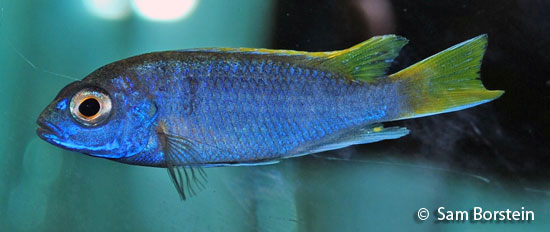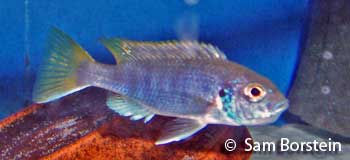Pseudotropheus elegans
Trewavas, 1935
Acei
Synonyms: Pseudotropheus sp. "acei", Gephyrochromis sp. "acei"

Above: A male yellow tail Pseudotropheus elegans. Photo by Sam Borstein.
Etymology:
Genus- Pseudotropheus= False Tropheus (Latin).
Species- elegans= elegant (Latin).
Intro:
Pseudotropheus elegans is a species with quite a taxonomic history! This fish actually happens to be the same as the very popular aquarium fish Pseudotropheus sp. "acei".
For a long time the fish in the hobby that was sold as Pseudotropheus elegans was actually Pseudotropheus livingstonii. It turns out that almost all fish in the hobby that were called Pseudotropheus livingstonii were in fact Metriaclima lanisticola and the true Pseudotropheus livingstonii were labeled as a Pseudotropheus elegans (Konings, 2007). This was thought to be a synonym for Pseudotropheus livingstonii, but Konings has reported in the October 2010 issue of Cichlid News that after looking at the type material of Pseudotropheus elegans, Pseudotropheus sp. "acei" fits the description very well and is in fact the true Pseudotropheus elegans.
This fish also occurs in many location variants. Here are some of the popular color varieties in the hobby:
- Yellow Fin- Found at Luwala and Msuli
- White Fin- From Ngara
Whether or not these color variants represent different species or not has not been concluded, but will most likey occur once a revision on this species is completed.
Distribution:
Pseudotropheus elegans is found in open water at many locations in Lake Malawi sometimes around sunken logs which they feed upon.
Size, Maturity, and Sexual Dimorphism:
Size: Males- 5 inches, Females- 3.5 inches
Maturity: 1.5 inches
Sexual Dimorphism: Males are larger than females. Both sexes have intense coloration; which makes it an ideal fish for the aquarium trade.

Above: A young, holding female Pseudotropheus elegans. Photo by Sam Borstein.
Care:
Acei pose no problems when it comes to keeping. The fish is peaceful and non-territiorial. This species does need swimming space because it is open water. Pseudotropheus elegans is nice in the sense that it will swim in the upper two-thirds of the tank, which many mbuna won't do. It is best to keep Acei in a decent sized group of at least 6 individuals as this is a social fish and occasionally will even school in aquarium. In the wild Pseudotropheus elegans are found in schools of thousands of individuals (Konings, 2007).
This fish is best kept with docile cichlids. One combo that works well and looks great is keeping the fish with Electric yellow Cichlids (Labidochromis caeruleus). This offers great color contrast and plenty of activity to a tank.
Diet:
In the wild this fish feeds upon algae that grow on sunken logs. They roam the open water in large schools searching for such feeding territories. In the aquarium, Pseudotropheus elegans will accept anything, but a high quality veggie flake should be part of the diet.
Breeding:
Pseudotropheus elegans is pretty easy to breed. The fish breed young and once started are hard to stop. Males will creat little depressions in the sand for spawning. Males display to females and then breeding commences in typical Pseudotropheus fashion over the substrate. The fish are good holders and a full term is a bout 18-20 days.
The fry are small and depending on the size of the female can number from a dozen to 60. The fry grow fast, especially on baby brine shrimp, and by a half inch are already getting a purple sheen to them. By an inch, the fins start turning yellow.
Conclusion:
Acei are one of my favorite mbuna. Personally, I think the yellow tail variaety is much nicer looking, but it seems that the white tail variety has more popularity currently. This fish is beautiful, peaceful, and easy to breed. I recommend it to anyone who wants to start with mbuna or anyone who has yet to keep this species and considers themselves a Malawi fanatic.
References:
- Konings, A. (2007) Malawi cichlids in their natural habitat. 4th ed., Cichlid Press, El Paso, Texas, 424 pp.
- Trewavas, E. (1935) A synopsis of the cichlid fishes of Lake Nyasa. Annals and Magazine of Natural History, 10, 65–118.
